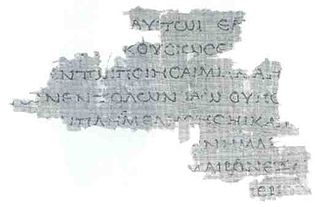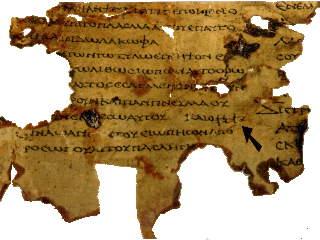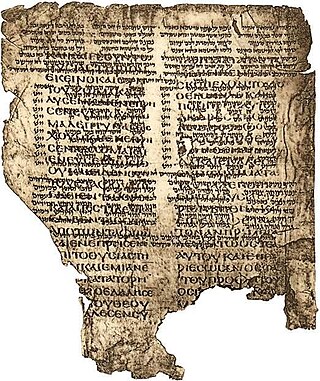
The Samaritan Torah, commonly called the Samaritan Pentateuch, is a text of the Torah written in the Samaritan script and used as sacred scripture by the Samaritans. It dates back to one of the ancient versions of the Hebrew Bible that existed during the Second Temple period, and constitutes the entire biblical canon in Samaritanism.
In contrast to the variety of absolute or personal names of God in the Old Testament, the New Testament uses only two, according to the International Standard Bible Encyclopaedia. From the 20th century onwards, "a number of scholars find various evidence for the name [YHWH or related form] in the New Testament.

In Christian scribal practice, nomina sacra is the abbreviation of several frequently occurring divine names or titles, especially in Greek manuscripts of the Bible. A nomen sacrum consists of two or more letters from the original word spanned by an overline.

Papyrus 66 is a near complete codex of the Gospel of John, and part of the collection known as the Bodmer Papyri.

The Tetragrammaton, or the Tetragram, is the four-letter Hebrew theonym יהוה, the name of God in the Hebrew Bible. The four letters, written and read from right to left, are yodh, he, waw, and he. The name may be derived from a verb that means "to be", "to exist", "to cause to become", or "to come to pass". While there is no consensus about the structure and etymology of the name, the form Yahweh is now accepted almost universally, though the vocalization Jehovah continues to have wide usage.

Papyrus 18, designated by 𝔓18, is an early copy of the New Testament in Greek. It is a papyrus manuscript containing the beginning of the Book of Revelation. It contains only Revelation 1:4–7. It is written against the fibres of the papyrus. On the other side of the papyrus is the ending of the book of Exodus. It is unclear whether the papyrus was a scroll of Exodus later reused for a copy of Revelation or a leaf from a codex with miscellaneous contents. The two sides of the papyrus were copied in different hands, but the original editor of the papyrus did not think there was a great interval of time between the copying of the two sides. He assigned the Exodus to the third century and the Revelation to the third or early fourth century.

The Papyrus Fouad 266 are fragments, part of a papyrus manuscript in scroll form containing the Greek translation, known as the Septuagint, of the Pentateuch. They have been assigned palaeographically to the 1st century BCE. There is discussion about whether the text is original or a later recension of the Septuagint.
Papyrus Oxyrhynchus 654 is a papyrus fragment of the logia of Jesus written in Greek. It is one of the Oxyrhynchus Papyri discovered by Grenfell and Hunt between 1897 and 1904 in the Egyptian town of Oxyrhynchus. The fragment is dated to the middle or late of the 3rd century. It is one of only three Greek manuscripts of the Gospel of Thomas.

The manuscript 4Q120 is a Septuagint manuscript (LXX) of the biblical Book of Leviticus written on papyrus, found at Qumran. The Rahlfs-No. is 802. Paleographically it dates from the first century BCE. Currently the manuscript is housed in the Rockefeller Museum in Jerusalem.

Papyrus Oxyrhynchus 1007 is a fragment of a Greek Septuagint manuscript written on parchment. The manuscript was discovered in Oxyrhynchus, modern El-Bahnasa, Egypt. Using the study of comparative writing styles (palaeography), the manuscript has been dated to the 3rd century CE.

The Greek Minor Prophets Scroll from Nahal Hever is a Greek manuscript of a revision of the Septuagint dated to the 1st century BC and the 1st century CE. The manuscript is kept in the Rockefeller Museum in Jerusalem. It was first published by Dominique Barthélemy in 1963. The Rahlfs-Siglum is 943.
The Papyrus Vindobonensis Graecus 39777 signed as SymP.Vindob.G.39777 – is a fragment of a Greek manuscript of the Psalms of the translation of Symmachus. It was written in papyrus in a scroll form. The papyrus contains fragments of Psalm 69 and Psalm 81. The P.Vindob.G.39777 is dated to late third century or beginning fourth century AD.

The Papyrus LXX Oxyrhynchus 3522, – is a small fragment of the Greek Septuagint (LXX) written in papyrus, in scroll form. As one of the manuscripts discovered at Oxyrhynchus it has been catalogued with the number 3522. Palaeographically it has been dated to the 1st century CE. The text agrees with the LXX.

Papyrus Oxyrhynchus 5101, designated by 2227, or P.Oxy.77 (LXXVII) 5101, is a manuscript of the Greek Septuagint Psalms, written on papyrus in roll form. It has survived in a very fragmentary condition. Using the study of comparative writings styles (palaeography), it has been dated to the middle of the first - middle of the second century CE.

The AqBurkitt are fragments of a palimpsest containing a portion of the Books of Kings from Aquila's translation of the Hebrew bible from the 6th century, overwritten by some liturgical poems of Yanai dating from the 9–11th century. This Aquila translation was performed approximately in the early or mid-second century C.E. The manuscript is variously dated to the 6th-century CE, or 5th-6th century CE.

Papyrus Oxyrhynchus 656 – is a Greek fragment of a Septuagint manuscript written on papyrus in codex form. This is a manuscript discovered at Oxyrhynchus, and it has been catalogued with number 656. Palaeographycally it is dated to late second century or early third century.
Dead Sea Scrolls manuscript 7Q1 is an early fragmentary manuscript of the Greek Bible containing verses from the Book of Exodus 28:4–7, written on papyrus. Using the study of comparative writing styles (palaeography), it has been dated to the hasmonean period, about late 2nd-early 1st century BCE.
The Papyrus Chester Beatty V is a fragment of a Greek Septuagint manuscript written on papyrus. It belongs to the Chester Beatty papyri. Using the study of comparative writing style (palaeography), it has been dated to the late 3rd century CE.
The Papyrus Leipzig Inv. 170 is a fragment of a septuagint manuscript written on papyrus in codex form that contains part of the Psalms. Palaeographically it has been dated to the 3rd century CE.
The Papyrus Chester Beatty VIII is a fragment of a septuagint manuscript that contains parts of the biblical Book of Jeremiah. Palaeographically it has been dated to the late second, early third century CE.












